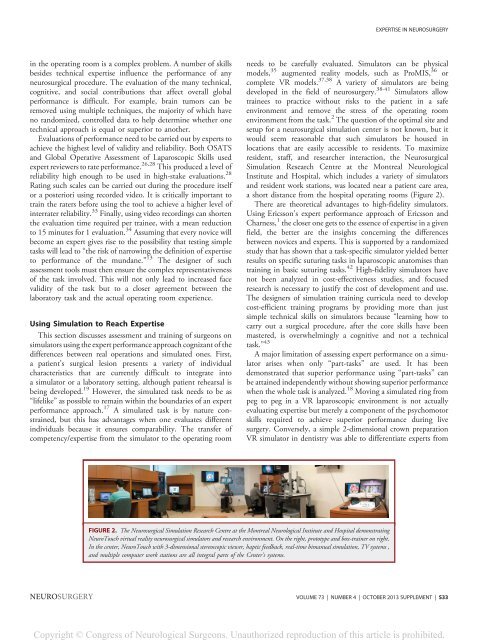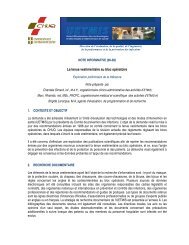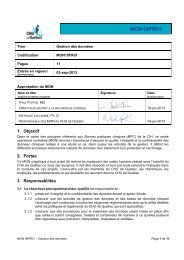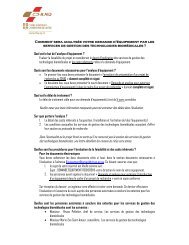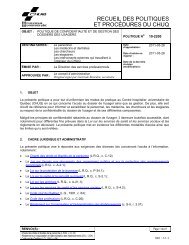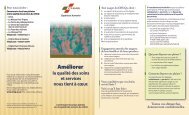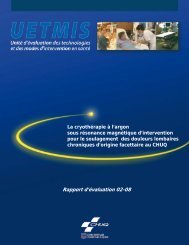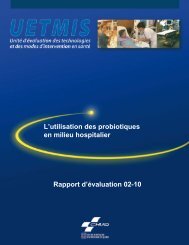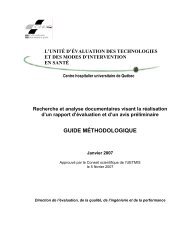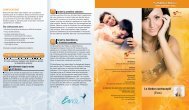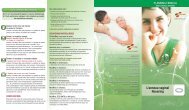Copyright © Congress of Neurological Surgeons. Unauthorized reproduction of this article is prohibited.EXPERTISE IN NEUROSURGERY<strong>in</strong> the operat<strong>in</strong>g room is a complex problem. A number of skillsbesides technical expertise <strong>in</strong>fluence the performance of anyneurosurgical procedure. The evaluation of the many technical,cognitive, and social contributions that affect overall globalperformance is difficult. For example, bra<strong>in</strong> tumors can beremoved us<strong>in</strong>g multiple techniques, the majority of which haveno randomized, controlled data to help determ<strong>in</strong>e whether onetechnical approach is equal or superior to another.Evaluations of performance need to be carried out by experts toachieve the highest level of validity and reliability. Both OSATSand Global Operative Assessment of Laparoscopic Skills usedexpert reviewers to rate performance. 26,28 This produced a level ofreliability high enough to be used <strong>in</strong> high-stake evaluations. 28Rat<strong>in</strong>g such scales can be carried out dur<strong>in</strong>g the procedure itselfor a posteriori us<strong>in</strong>g recorded video. It is critically important totra<strong>in</strong> the raters before us<strong>in</strong>g the tool to achieve a higher level of<strong>in</strong>terrater reliability. 33 F<strong>in</strong>ally, us<strong>in</strong>g video record<strong>in</strong>gs can shortenthe evaluation time required per tra<strong>in</strong>ee, with a mean reductionto 15 m<strong>in</strong>utes for 1 evaluation. 34 Assum<strong>in</strong>g that every novice willbecome an expert gives rise to the possibility that test<strong>in</strong>g simpletasks will lead to “the risk of narrow<strong>in</strong>g the def<strong>in</strong>ition of expertiseto performance of the mundane.” 13 The designer of suchassessment tools must then ensure the complex representativenessof the task <strong>in</strong>volved. This will not only lead to <strong>in</strong>creased facevalidity of the task but to a closer agreement between thelaboratory task and the actual operat<strong>in</strong>g room experience.Us<strong>in</strong>g Simulation to Reach <strong>Expertise</strong>This section discusses assessment and tra<strong>in</strong><strong>in</strong>g of surgeons onsimulators us<strong>in</strong>g the expert performance approach cognizant of thedifferences between real operations and simulated ones. First,a patient’s surgical lesion presents a variety of <strong>in</strong>dividualcharacteristics that are currently difficult to <strong>in</strong>tegrate <strong>in</strong>toa simulator or a laboratory sett<strong>in</strong>g, although patient rehearsal isbe<strong>in</strong>g developed. 19 However, the simulated task needs to be as“lifelike” as possible to rema<strong>in</strong> with<strong>in</strong> the boundaries of an expertperformance approach. 17 A simulated task is by nature constra<strong>in</strong>ed,but this has advantages when one evaluates different<strong>in</strong>dividuals because it ensures comparability. The transfer ofcompetency/expertise from the simulator to the operat<strong>in</strong>g roomneeds to be carefully evaluated. Simulators can be physicalmodels, 35 augmented reality models, such as ProMIS, 36 orcomplete VR models. 37,38 A variety of simulators are be<strong>in</strong>gdeveloped <strong>in</strong> the field of neurosurgery. 38-41 Simulators allowtra<strong>in</strong>ees to practice without risks to the patient <strong>in</strong> a safeenvironment and remove the stress of the operat<strong>in</strong>g roomenvironment from the task. 2 The question of the optimal site andsetup for a neurosurgical simulation center is not known, but itwould seem reasonable that such simulators be housed <strong>in</strong>locations that are easily accessible to residents. To maximizeresident, staff, and researcher <strong>in</strong>teraction, the NeurosurgicalSimulation Research Centre at the Montreal NeurologicalInstitute and Hospital, which <strong>in</strong>cludes a variety of simulatorsand resident work stations, was located near a patient care area,a short distance from the hospital operat<strong>in</strong>g rooms (Figure 2).There are theoretical advantages to high-fidelity simulators.Us<strong>in</strong>g Ericsson’s expert performance approach of Ericsson andCharness, 1 the closer one gets to the essence of expertise <strong>in</strong> a givenfield, the better are the <strong>in</strong>sights concern<strong>in</strong>g the differencesbetween novices and experts. This is supported by a randomizedstudy that has shown that a task-specific simulator yielded betterresults on specific sutur<strong>in</strong>g tasks <strong>in</strong> laparoscopic anatomises thantra<strong>in</strong><strong>in</strong>g <strong>in</strong> basic sutur<strong>in</strong>g tasks. 42 High-fidelity simulators havenot been analyzed <strong>in</strong> cost-effectiveness studies, and focusedresearch is necessary to justify the cost of development and use.The designers of simulation tra<strong>in</strong><strong>in</strong>g curricula need to developcost-efficient tra<strong>in</strong><strong>in</strong>g programs by provid<strong>in</strong>g more than justsimple technical skills on simulators because “learn<strong>in</strong>g how tocarry out a surgical procedure, after the core skills have beenmastered, is overwhelm<strong>in</strong>gly a cognitive and not a technicaltask.” 43A major limitation of assess<strong>in</strong>g expert performance on a simulatorarises when only “part-tasks” are used. It has beendemonstrated that superior performance us<strong>in</strong>g “part-tasks” canbe atta<strong>in</strong>ed <strong>in</strong>dependently without show<strong>in</strong>g superior performancewhen the whole task is analyzed. 18 Mov<strong>in</strong>g a simulated r<strong>in</strong>g frompeg to peg <strong>in</strong> a VR laparoscopic environment is not actuallyevaluat<strong>in</strong>g expertise but merely a component of the psychomotorskills required to achieve superior performance dur<strong>in</strong>g livesurgery. Conversely, a simple 2-dimensional crown preparationVR simulator <strong>in</strong> dentistry was able to differentiate experts fromFIGURE 2. The Neurosurgical Simulation Research Centre at the Montreal Neurological Institute and Hospital demonstrat<strong>in</strong>gNeuroTouch virtual reality neurosurgical simulators and research environment. On the right, prototype and box-tra<strong>in</strong>er on right.In the center, NeuroTouch with 3-dimensional stereoscopic viewer, haptic feedback, real-time bimanual simulation, TV systems ,and multiple computer work stations are all <strong>in</strong>tegral parts of the Center’s systems.NEUROSURGERYVOLUME 73 | NUMBER 4 | OCTOBER 2013 SUPPLEMENT | S33
Copyright © Congress of Neurological Surgeons. Unauthorized reproduction of this article is prohibited.GÉLINAS-PHANEUF AND DEL MAESTROnovices. 44 The aviation <strong>in</strong>dustry uses “almost real” to tra<strong>in</strong> pilots.Tasks are effectively complete, and part-tasks are not practicedbecause the actual cockpit is used and not a simplification of the<strong>in</strong>struments needed to pilot the plane. 45 Develop<strong>in</strong>g patientspecificreconstruction for tra<strong>in</strong><strong>in</strong>g and rehearsal is a future goal ofVR surgical simulators, 19 but its full <strong>in</strong>tegration <strong>in</strong>to a virtualneurosurgical operat<strong>in</strong>g room will take time. Some systems arecurrently try<strong>in</strong>g to <strong>in</strong>tegrate patient-specific data, notably dur<strong>in</strong>ganeurysm clipp<strong>in</strong>g simulation on the Dextroscope 46 and tumorresection on the NeuroTouch. 19Simulated tasks and performance metrics on such tasks need tobe validated before be<strong>in</strong>g <strong>in</strong>tegrated <strong>in</strong>to a tra<strong>in</strong><strong>in</strong>g curriculum.Kneebone 47 has outl<strong>in</strong>ed a conceptual framework of sucha program <strong>in</strong>tegrat<strong>in</strong>g simulation. He postulated that simulation<strong>in</strong> this context must atta<strong>in</strong> 4 goals: (1) deliberate practice <strong>in</strong> a safeenvironment, (2) availability of expert tutors who can effectivelyscaffold and enhance the teach<strong>in</strong>g material, (3) authenticsimulation that fits <strong>in</strong> a community of practice, and (4) anenvironment that takes <strong>in</strong>to account the emotional component oflearn<strong>in</strong>g. These 4 theoretical goals have not been adequatelyaddressed and evaluated regard<strong>in</strong>g simulation surgical tra<strong>in</strong><strong>in</strong>g.Currently, most performances on simulators are evaluated us<strong>in</strong>gperformance metrics generated by computer systems. All VRsimulators use different metrics that are not standardized acrosscompanies, mak<strong>in</strong>g mean<strong>in</strong>gful comparisons between simulatorsdifficult. 19,36,48-50 Even with reliable metrics, some studies havefailed to show consistent construct validity, further limit<strong>in</strong>g theiruse <strong>in</strong> a tra<strong>in</strong><strong>in</strong>g curriculum. 50 Future VR simulators should usenovel, specific, and quantifiable metrics that can be thoroughlyassessed for both construct validity and reliability beforewidespread adoption.The expert performance model outl<strong>in</strong>es that laboratory/simulatedtasks need to be constra<strong>in</strong>ed to ensure repeatability and objectiveassessment. 18 Once expert performance is achieved on thesimulator, one should determ<strong>in</strong>e whether this expertise willimprove the performance of the surgeon dur<strong>in</strong>g “real” surgeries.Recent randomized, controlled trials and meta-analyses haveaddressed these issues. 51-55 Data from these studies show thatexpert performance on a VR simulated task is associated withimproved levels of performance us<strong>in</strong>g both pig models 56 and actual“live” human surgeries. 55Simulators <strong>in</strong> neurosurgery can be used to explore 2 questionsthat relate directly to the question of neurosurgical expertise. First,how do expert neurosurgeons actually perform neurosurgicaloperations? Can questions such as what visual, tactile, and/orother cues are expert surgeons us<strong>in</strong>g dur<strong>in</strong>g the technicalcomponents of their operations be assessed us<strong>in</strong>g simulationtechnology? Second, with the proper simulation tools andcurriculum can the goal of neurosurgical tra<strong>in</strong><strong>in</strong>g programs beshifted from teach<strong>in</strong>g to competence to teach<strong>in</strong>g to expert level? Anumber of new simulation systems are be<strong>in</strong>g developed <strong>in</strong> the areaof neurosurgery. 19,38,40,57,58 A new project, NeuroTouch, iscurrently under development at the National Research Council ofCanada. 19,38,59 The goal of this project is to develop a VRneurosurgical simulator <strong>in</strong> 3 dimensions with haptic feedback(Figure 2). The usefulness of this or other simulators <strong>in</strong> theassessment of expert performance and resident tra<strong>in</strong><strong>in</strong>g rema<strong>in</strong>sto be def<strong>in</strong>ed.A Tra<strong>in</strong><strong>in</strong>g Curriculum Target<strong>in</strong>g <strong>Expertise</strong>: Is Ita Possible Goal?An expert performance approach to study<strong>in</strong>g neurosurgicaltechnical expertise should be transferable to a tra<strong>in</strong><strong>in</strong>g curriculum.Because the literature on the topic primarily <strong>in</strong>volves generalsurgery, a number of assumptions will need to be made to<strong>in</strong>corporate these research results <strong>in</strong>to the development ofneurosurgical curriculum. First, the theory of expert performanceis a general theory, with possible applications <strong>in</strong> a variety of fields,<strong>in</strong>clud<strong>in</strong>g neurosurgery. 17 Second, deliberate practice will bea s<strong>in</strong>e qua non requirement <strong>in</strong> such a program. 20 Third, expertswill be assumed to be highly competent neurosurgeons for thesake of the discussion because no consensual def<strong>in</strong>ition exists as towhat an expert neurosurgeon is. Fourth, feedback is an essentialbuild<strong>in</strong>g block of such a program. 20 F<strong>in</strong>ally, such a tra<strong>in</strong><strong>in</strong>gprogram should use current adult learn<strong>in</strong>g theories to achievemaximal efficiency. 60The pressure to change the tra<strong>in</strong><strong>in</strong>g curriculum, focus<strong>in</strong>g onsurgical skills, is an important issue faced by all neurosurgicalresidency tra<strong>in</strong><strong>in</strong>g committees. 61 There are no reasons to preventsimulation from play<strong>in</strong>g a major role <strong>in</strong> the neurosurgicaleducation of tra<strong>in</strong>ees, focused on improv<strong>in</strong>g their technical skillsacquisition. 62 The use of simulation <strong>in</strong> a curriculum “should bedriven by educational imperatives and not by technological<strong>in</strong>novation.” 43 Objective assessment of technical skills is possibleto a high degree of validity and reliability <strong>in</strong> surgery, with somedata be<strong>in</strong>g developed for neurosurgery (Gél<strong>in</strong>as-Phaneuf et al.2013, unpublished work). 63 Initial studies <strong>in</strong>volv<strong>in</strong>g medicalstudents and neurosurgical residents were conducted <strong>in</strong> a pilotvalidation study us<strong>in</strong>g a NeuroTouch tumor resection scenarioand demonstrated face, content, and construct validity <strong>in</strong>a competitive sett<strong>in</strong>g. 63 At present, studies are be<strong>in</strong>g conductedus<strong>in</strong>g “expert” neurosurgeons <strong>in</strong> noncompetitive sett<strong>in</strong>gs to<strong>in</strong>crease our understand<strong>in</strong>g of expert neurosurgical performance.Hence, the first requirement of an expert performance approachto assess and tra<strong>in</strong> neurosurgeons is possible because tasks (eg, theremoval of an <strong>in</strong>tracranial men<strong>in</strong>gioma or metastasis) can beobjectively measured <strong>in</strong> terms of performance. Deliberate practice<strong>in</strong> an expertise-oriented curriculum is essential. Multiplepublications have consistently demonstrated that expert performers<strong>in</strong> a variety of fields have more than 10 years of purposefulpractice to achieve an <strong>in</strong>ternational level of expertise. 20 In thefield of surgery, <strong>in</strong>nate talent has not been clearly demonstrated,61 and contradictive studies have associated higher thecorrelation of visuospatial skills to “expert” surgical performancerema<strong>in</strong>s unclear. 64-66 Deliberate practice paradigms will need tobe <strong>in</strong>corporated <strong>in</strong>to the design of any curriculum whose goal isto tra<strong>in</strong> to specific levels of expertise. Ericsson 20 demonstratedS34 | VOLUME 73 | NUMBER 4 | OCTOBER 2013 SUPPLEMENTwww.neurosurgery-onl<strong>in</strong>e.com


